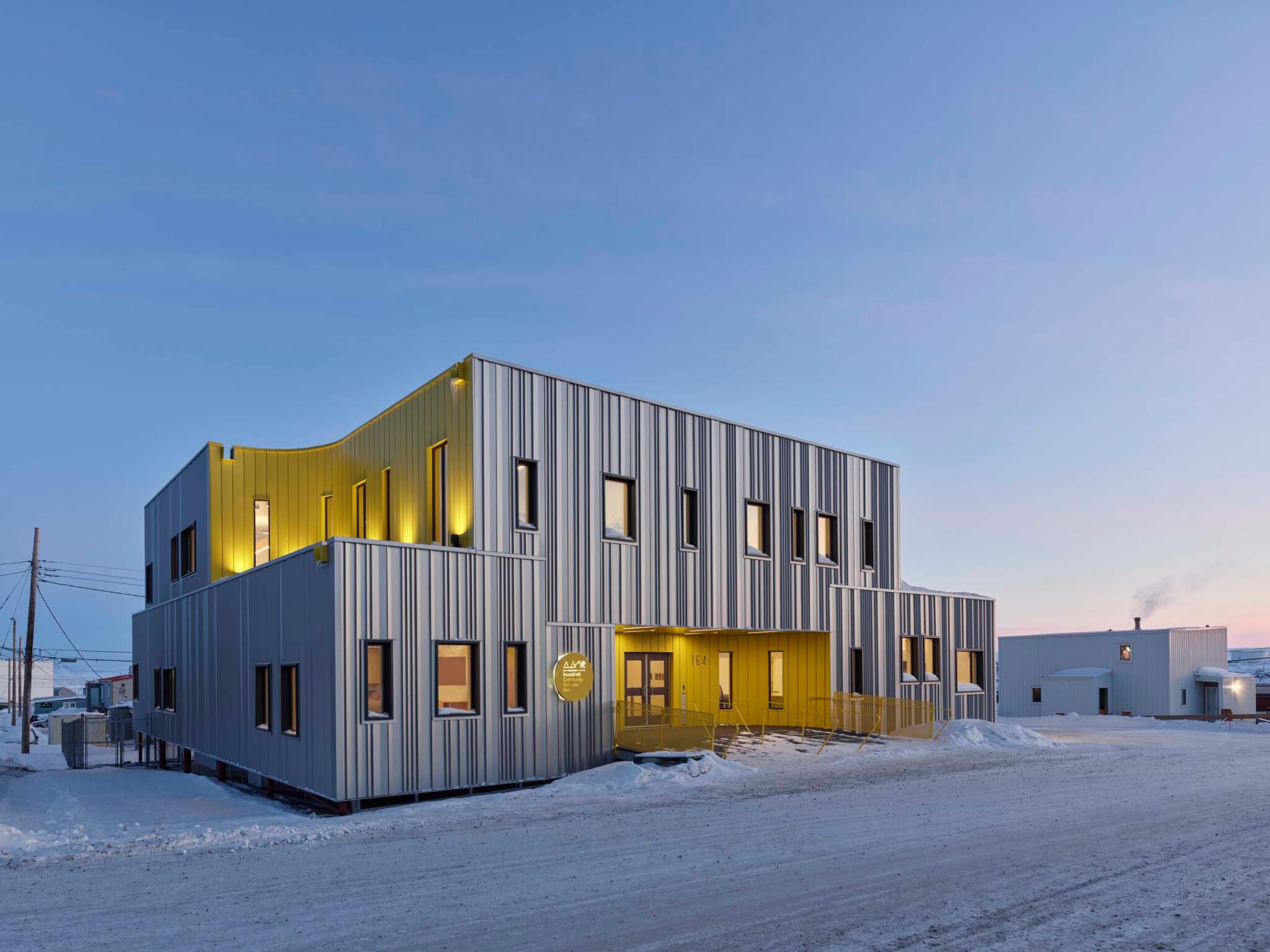Lateral Office, a small Toronto-based practice, has completed work on the Innuusirvik Community Wellness Hub (ICWH) in Iqaluit, Nunavut. The 2-story building, located in the heart of downtown Iqaluit, was designed for the Qaujigiartiit Health Research Centre, a female-led nonprofit that combines traditional Inuit knowledge and cultural practices with scientific research to improve public health in Nunavut.
The ICWH is designed to withstand the Arctic’s extreme climate. Due to Nunavut’s remote location, material choices were limited by the region’s restricted supply chain. Accordingly, simple corrugated metal panels clad the new building, providing durability and facilitating easy maintenance.

Iqaluit is currently the most rapidly growing city in Canada. This expansion is driven by a number of factors, chief among them a robust mining industry, large government sector (Iqaluit is the capital of the Nunavut territory), and high per capita birth rate.
Mason White, founding partner of Lateral Office, elaborated on the challenges facing the city: “More than 50 percent of the population is under the age of 25 and a majority of the Inuit population are still healing from Canadian colonial violence, with people holding on to, and rekindling, threatened cultural traditions such as hunting, language, and social practices.”
Prior to their work on the project, Lateral Office published Many Norths: Spatial Practice in a Polar Territory, a book which looks at the challenges facing the built environment in Canada’s Arctic North.

Lateral Office used vernacular building practices as a starting point for the design of the new ICWH building. Often constructed from wood and metal, structures in the region are largely utilitarian and painted bright colors to stand out in the snow.
The building’s construction was beset by a number of challenges inherent to Nunavut’s isolation. Material supply schedules in the region are tied to sealift—the annual shipment of goods from ports in the South to Nunavut—because there are no roads connecting Southern Canada to Baffin Island, the large land mass that contains Iqaluit. To further complicate things, Sealift can only occur when the Hudson Strait has completely thawed during the summer months.

The design of the building proceeds rationally from the environmental conditions of the site. For example, the entire structure is lifted on piles to avoid melting the permafrost, a layer of permanently frozen soil. Because the permafrost contains frozen water, a building placed directly on the ground can cause this layer to melt, sinking the building along with it.
Special “adfreeze” piles were used: metal pipes that bond to the permafrost. Lateral Office also worked to avoid “frost-jacking,” where the foundation is pushed out of the ground by ice.
“Building in the Arctic is a delicate balance of resisting sinking down and pushing up that needs to be achieved for the lifetime of the building,” added White. “With climate change, the challenge of finding stable ground is only increasing.”

Essentially rectangular in shape, the ICWH features several functional subtractions across its mass. The first, located on the ground floor, creates a wind-protected entrance to the building. In addition, three of the corners on the building’s second story are missing, as if they have been “scooped away,” to deflect wind and provide space for an Arctic green roof in the summer months.
These negative spaces are colored yellow. According to the architects, the color was chosen for a number of reasons. Yellow stands out in the snow and features prominently in Nunavut’s flag as well as Inuit culture—its also an architectural homage to Iqaluit’s former airport building, which was painted bright yellow.
Curiously, the building is not designed—as most are in Northern climates—to shed snow accumulation.
“The Inuit taught us that snow structures, or igloos, can be warm enough if you build it right,” White told AN. “Packed snow is a naturally insulating material…we wanted to intentionally integrate snowdrifts into the design intent. By allowing snow to accumulate on the roof its helps extend the insulation of the building in the colder months,” he added.

The interior of ICWH is programmed to include a library, community gathering space, daycare, and wellness research center. A wood-paneled rotunda rises through both levels of the structure, fed by a skylight on the roof of the building. Ornamental decorations on the walls of the rotunda reference Inuit craft culture and a colorful mural decorates the floor.
To further their mission, the Qaujigiartiit Health Research Centre is currently developing a youth center and family friendly apartments directly adjacent to the ICWH, a structure that Lateral Office will also design. In addition, White shared that the firm hopes to continue explore the use of packed snow with this new project, “incorporating snow as part of the R-value assessment.”
Project Specifications
-
- Architect of Record: Verne Reimer Architecture
- Landscape Architect: Lateral Office
- Interior Design: Lateral Office
- Structural Engineer: WSP Canada
- Electrical Engineer: WSP Canada
- Civil Engineer: WSP Canada
- Lighting Design: Lateral Office, WSP Canada
- Signage / Wayfinding: Lateral Office
- General Contractor: NCC Development
- Client Representative: Michael J. LeBlanc
- Facade Installation: NCC Development
- Cladding: Morin Corp, VicWest
- Windows: Kohltech Windows
- Doors: Allmar

